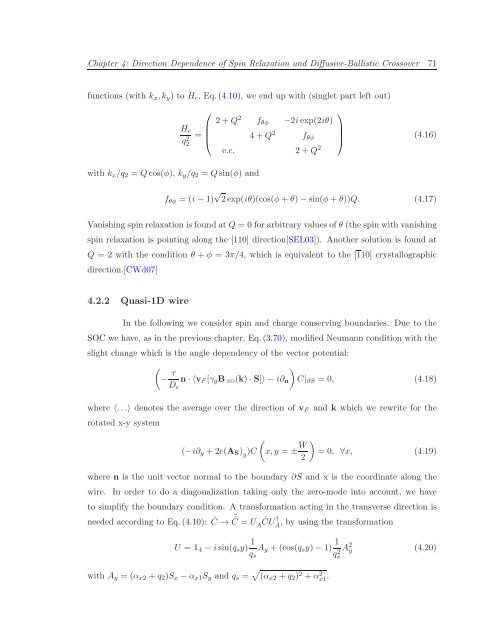Itinerant Spin Dynamics in Structures of ... - Jacobs University
Itinerant Spin Dynamics in Structures of ... - Jacobs University
Itinerant Spin Dynamics in Structures of ... - Jacobs University
Create successful ePaper yourself
Turn your PDF publications into a flip-book with our unique Google optimized e-Paper software.
Chapter 4: Direction Dependence <strong>of</strong> <strong>Sp<strong>in</strong></strong> Relaxation and Diffusive-Ballistic Crossover 71<br />
functions (with k x ,k y ) to H c , Eq.(4.10), we end up with (s<strong>in</strong>glet part left out)<br />
H c<br />
q 2 2<br />
=<br />
⎛<br />
⎜<br />
⎝<br />
⎞<br />
2+Q 2 f θφ −2i exp(2iθ)<br />
4+Q 2 f ⎟ θφ ⎠ (4.16)<br />
c.c. 2+Q 2<br />
with k x /q 2 = Qcos(φ), k y /q 2 = Qs<strong>in</strong>(φ) and<br />
f θφ = (i −1) √ 2exp(iθ)(cos(φ+θ)−s<strong>in</strong>(φ+θ))Q. (4.17)<br />
Vanish<strong>in</strong>g sp<strong>in</strong>relaxation is foundat Q = 0 for arbitrary values <strong>of</strong> θ (the sp<strong>in</strong>with vanish<strong>in</strong>g<br />
sp<strong>in</strong> relaxation is po<strong>in</strong>t<strong>in</strong>g along the [110] direction[SEL03]). Another solution is found at<br />
Q = 2 with the condition θ + φ = 3π/4, which is equivalent to the [110] crystallographic<br />
direction.[CWd07]<br />
4.2.2 Quasi-1D wire<br />
In the follow<strong>in</strong>g we consider sp<strong>in</strong> and charge conserv<strong>in</strong>g boundaries. Due to the<br />
SOC we have, as <strong>in</strong> the previous chapter, Eq.(3.70), modified Neumann condition with the<br />
slight change which is the angle dependency <strong>of</strong> the vector potential:<br />
(− τ D e<br />
n·〈v F [γ g B SO (k)·S]〉−i∂ n<br />
)<br />
C| ∂S = 0, (4.18)<br />
where 〈...〉 denotes the average over the direction <strong>of</strong> v F and k which we rewrite for the<br />
rotated x-y system<br />
(−i∂ y +2e(A S ) y<br />
)C<br />
(<br />
x,y = ± W )<br />
= 0, ∀x, (4.19)<br />
2<br />
where n is the unit vector normal to the boundary ∂S and x is the coord<strong>in</strong>ate along the<br />
wire. In order to do a diagonalization tak<strong>in</strong>g only the zero-mode <strong>in</strong>to account, we have<br />
to simplify the boundary condition. A transformation act<strong>in</strong>g <strong>in</strong> the transverse direction is<br />
needed accord<strong>in</strong>g to Eq.(4.10): Ĉ → ˜Ĉ = U A ĈU † A<br />
, by us<strong>in</strong>g the transformation<br />
U =½4 −i s<strong>in</strong>(q s y) 1 q s<br />
A y +(cos(q s y)−1) 1 q 2 sA 2 y (4.20)<br />
with A y = (α x2 +q 2 )S x −α x1 S y and q s = √ (α x2 +q 2 ) 2 +α 2 x1 .
















